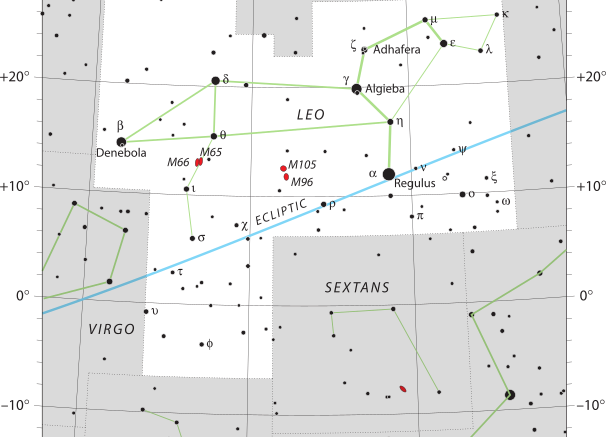Located in the northern celestial hemisphere, Leo is one of the constellations of the zodiac. Its name is Latin for lion, and to the ancient Greeks represented the Nemean Lion killed by the mythical Greek hero Heracles. It was 1 of the 48 constellations described by the 2nd-century astronomer Ptolemy, and is one of the most easily recognizable due to its many bright stars and a distinctive shape that is reminiscent of the crouching lion it depicts. The lion’s mane and shoulders also form an asterism known as “The Sickle,” which to modern observers may resemble a backwards “question mark.”
| Applicable Information | |
| Visibility In Pacific Northwest | October to June |
| Best Times To View | April |
| Right Ascension | 11h |
| Declination | +15° |
| Area | 947 square degrees |
| Main Stars | 5, 9 |
| Brightest Object | Regulus (α Leo) |
| Meteor showers | Leonids |
| Messier objects | 5 |
| Neighboring Constellations | Ursa Major, Leo Minor, Cancer, Hydra, Sextans, Crater, Virgo, Lynx |
History
Leo was one of the earliest recognized constellations, with archaeological evidence that the Mesopotamians had a similar constellation as early as 4000 BCE. The Persians called Leo Ser or Shir; the Turks, Artan; the Syrians, Aryo; the Jews, Arye; the Indians, Simha, all meaning “lion”. Greek stamp depicting a mosaical image of the encounter between Hercules and Leo,the Nemean Lion.
Some mythologists believe that in Sumeria, Leo represented the monster Humbaba, who was killed by Gilgamesh.
In Babylonian astronomy, the constellation was called UR.GU.LA, the “Great Lion”; the bright star Regulus was known as “the star that stands at the Lion’s breast.” Regulus also had distinctly regal associations, as it was known as the King Star.
In Greek mythology, Leo was identified as the Nemean Lion which was killed by Heracles during the first of his twelve labours.
The Roman poet Ovid called it Herculeus Leo and Violentus Leo. Bacchi Sidus was another of its titles, the god Bacchus always being identified with this animal. However, Manilius called it Jovis et Junonis Sidus.
Stars
Leo contains many bright stars, many of which were individually identified by ancient astronomers. 4 stars are of first or second magnitude, which render this constellation especially prominent.
- Regulus, designated Alpha Leonis, is a blue-white main-sequence star that is a double star divisible in binoculars. The traditional name (Regulus) means “the little king”.
- Beta Leonis, called Denebola, is at the opposite end of the constellation to Regulus.
- Algieba, Gamma Leonis, is a binary star that has the primary and secondary are divisible in small telescopes and the tertiary is visible in binoculars.
- Delta Leonis, called Zosma, is a blue-white star of magnitude 2.58, 58 light-years from Earth.
The Leo Ring, a cloud of hydrogen, helium gas, is found in orbit of two galaxies found within the Leo constellation.
Leo contains many bright galaxies; Messier 65, Messier 66, Messier 95, Messier 96, Messier 105, and NGC 3628 are the most famous, the first two being part of the Leo Triplet.
Messier 65 is an intermediate spiral galaxy that was discovered in 1780. It is visible in large binoculars or small telescopes, but its concentrated nuclei and elongation are only visible in large amateur instruments.
M66 is a spiral galaxy that is part of the Leo Triplet.. It is at a distance of 37 million light-years and has a somewhat distorted shape due to gravitational interactions with the other members of the Triplet. Both M65 is visible in large binoculars or small telescopes, but its concentrated nuclei and elongation are only visible in large amateur instruments.
M95 and M96 are both spiral galaxies 20 million light-years from Earth. Though they are visible as fuzzy objects in small telescopes, their structure is only visible in larger instruments. M95 is a barred spiral galaxy.
M105 is about a degree away from the M95/M96 pair; it is an elliptical galaxy. It is the largest elliptical in the Messier catalog that is not a member of the Virgo cluster of galaxies. M105 can be spotted with a small telescope, and large telescopes will uncover two fainter galaxies close to the bright elliptical.
M106 is a spiral galaxy that can be spotted with a small telescope.
Make sure to check out other articles on the site, including a brief introduction to constellations, other constellation articles, and more!

Be the first to comment on "Leo"